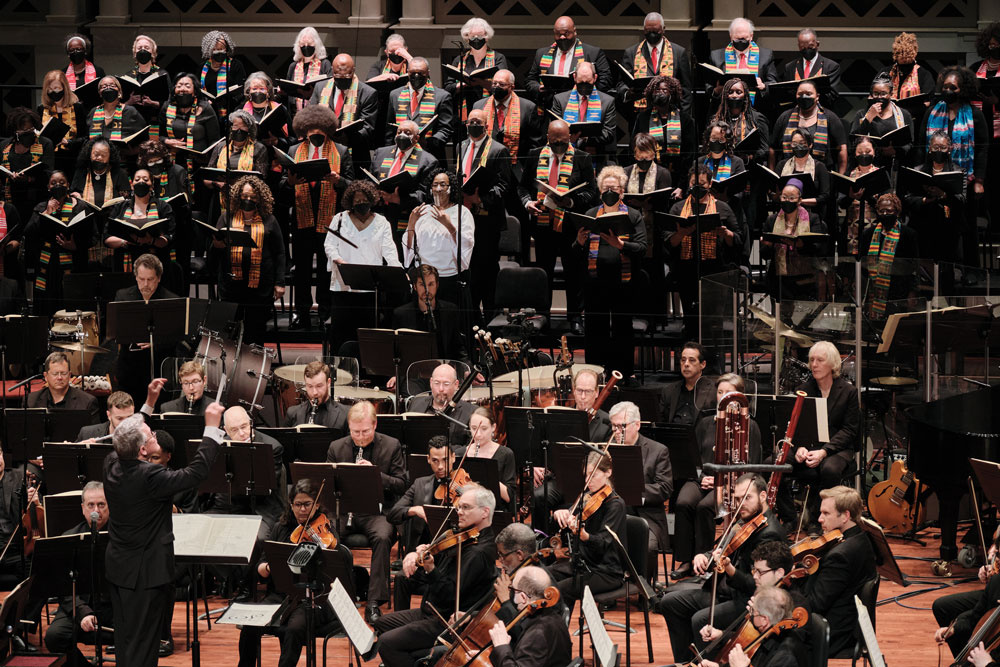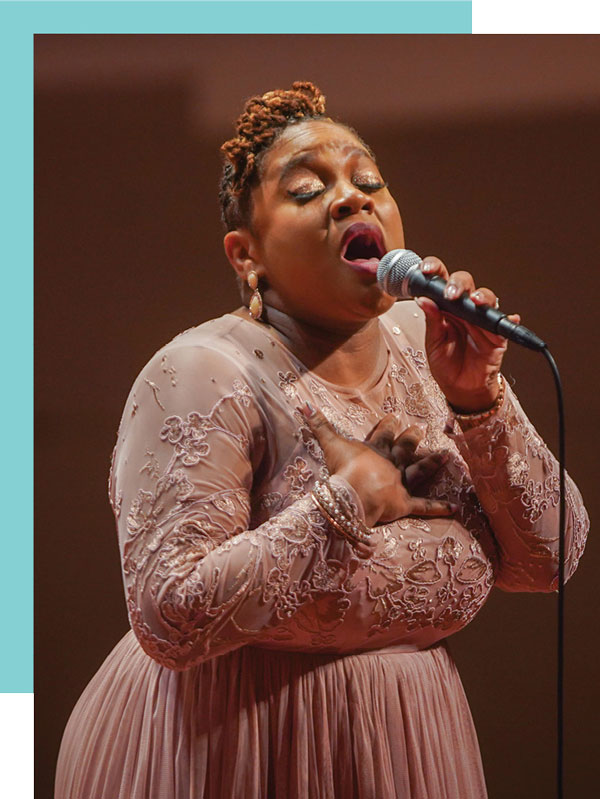The Shared Room: Embracing the Classical Roots Community Choir Concert Experience
by Davia J. Crutchfield, Ph.D.

The Classical Roots Community Choir remains a staple of Cincinnati’s arts and educational experiences. Through carefully curated programming, each year’s concert embarks on collaborative expressions of Black cultural music and pays tribute to the historical contributions of Black artists and composers. Similarly, this year’s presentation explores traditional and contemporary expressions of gospel music, honoring genre icon Donald Lawrence, at its center. Additionally, this year’s presentation notes the versatility of gospel music by including the contributions of opera maestro George Shirley, composer Rosephanye Powell, and the contemporary spiritual expressions of Adolphus Hailstork.

At the helm of Black cultural influences and artistic contributions is the importance of Black communal respect and appreciation. This year, the Classical Roots Community Choir demonstrates their personal and professional commitment to this initiative in their dedication to creating a harmonious experience set to transcend the walls of Music Hall. The objective is clear: in order to ensure that the expansion of art and the inclusivity of artist contributions continue for generations to come, the future of Cincinnati arts and artistic communities must incorporate culturally relevant practices and programs. Chorus interim director Jason Alexander Holmes shared that the reciprocal respect of one’s cultural knowledge, heritage and life experiences became the rubric for the performers’ preparation and baseline for the audience’s experience.

The Classical Roots Community Choir is a response to the Cincinnati Symphony Orchestra’s pledge to cultivate a symbiotic relationship between itself and Cincinnati’s cross-cultural communities. In kind, program organizers consulted with Donald Lawrence to maximize a welcoming and impactful experience. His return to Cincinnati signaled a homecoming for many Cincinnatians familiar with both his local history and career catalogue. This year’s concert is designed to honor his career commitment to amplifying gospel music as a multi-genre art form and the historical influences that contributed to his creative lens.
The chorus and orchestral ensemble also reflect an amalgamation. This ensemble displays varied learning styles and practices that collectively work toward the goal of spiritual and musical elevation. This combination centers themes of education and community, using both to pull together a program intersecting the impressions of classical music, spiritual traditions and contemporary applications. It is this juxtaposition of education and community that amplifies the ensemble’s perforative repertoire and serves as the Sankofa* experience for future practices and programmatic opportunities.
Orchestral conductor John Morris Russell champions this sentiment, noting his experiences teaching in Ohio public schools and international symphonic directorships. The shared outcome of working with artists at any level rests on their communication dynamics and willingness to approach each rehearsal with their absolute best. The “fantastic zone”—as he calls it—is the apex of harmony, only created when artists ascend to higher levels of cohesive performance.

Classical Roots Community Choir member and veteran community chorus participant Ciara Harper describes this as an intergenerational, multicultural cohesion. She notes this collaboration “is the coming together of different people with [a] common goal...showcasing it to people who want to be exposed. We don’t all look the same, but [this] collaboration requires all of us.”
This conjoined building of sound, understanding of the music’s message and the embrace of the project’s goal translates across artistic styles and worship experiences. The internal community produced within this ensemble reflects those who enjoy their respective crafts and believe in equality. The ongoing success of the Classical Roots Community Choir and Classical Roots concert includes participant and executive support, the Multicultural Awareness Council, chorus volunteers, and various arts activists working in tandem to make the orchestral experience relevant and remarkable.
This year’s participant numbers resemble pre-pandemic attendance. Their unified hope to revitalize the Classical Roots Community Choir will rebuild this extended family and further create deeper, meaningful content. After several weeks of rehearsals, there is a shared mutual investment in providing an outstanding show experience. There is also the mutual investment in protecting the energy created by their collective; the collective gives the feelings of home. The ensemble’s cohesive expression is not just the process of presenting a song; it is the accurate expression of the heart behind the message. Donald Lawrence upholds this as the pinnacle in his teaching; under his tutelage he stresses the importance of delivering the song’s message with the weight and conviction of its author. He conveys the effect as “speaking to the listener;” a practice that upholds the musical and spiritual integrity of the pieces. This responsibility is characteristic of Black music, and gospel music especially.

Credit: Tyler Secor
Lawrence and interim Choir director Holmes regard the Black Church as an important teaching vehicle, with Lawrence observing the institution as “a non-accredited conservatory.” He equated its teaching to that of a year-intensive, including ear training, music theory and vocal pedagogy. He stated this staple of American Black culture has “given us the greatest singers in the world,” and gospel music deserved the same appreciation as opera and jazz. Lawrence’s determination to present gospel music as art increased its interdisciplinary reach.
Choir member Harper further upheld this sentiment. Her active participation in community concert spaces provided significant opportunities to share vocal instrumentation and gospel expressions outside traditional church environments. These opportunities created a common ground within the arts; it is at this common ground that Lawrence hoped the audience would appreciate gospel’s complexity and richness.
The long-term impact of the Classical Roots Community Choir and Concert is an intergenerational, collective appreciation for various styles of music, and the contributions of Black composers and artists. The Symphony Orchestra’s desire to raise the city’s consciousness through music requires the continuation of culturally inclusive programming. Consensus has been reached: the shared room created by this concert experience transforms the artists, directors and the audience. As the excitement for the concert builds, the future of the Classical Roots Community Choir also builds. As Holmes stated, “I feel about [the concert series] the way I feel about Black history—it is our history, American history, global history. Cincinnati has so much rich, Black, arts history that we could celebrate every month and not get bored.”
*The spirit of Sankofa, a word from the Twi language of Ghana that means “go back and get it,” encompasses taking from the past what is good and bringing it into the present to make progress in the future. Sankofa is symbolized by a bird with its feet facing forward and its head looking back.